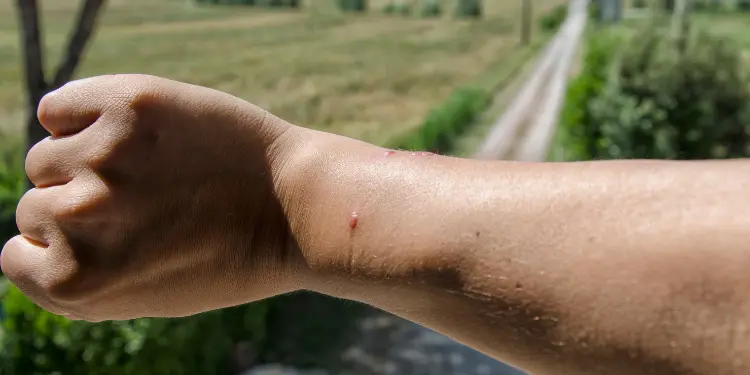Redback spider bites marks can cause significant pain and concern. These spiders are frequently encountered in Australia, and their bites can result in serious health issues. This guide will demonstrate how to identify a redback spider bite mark and the appropriate redback spider bite first aid steps to take afterwards.
Discover how to protect yourself from these arachnids.
Key Takeaways
- Redback spider bites cause severe pain that can last for days and spread to other body parts.
- Apply ice, give pain meds, and call the Poisons Info Centre on 13 11 26 right away if bitten.
- Seek medical help if pain persists, as a doctor may need to give antivenom.
- Keep bite areas clean and dry, but don’t use pressure bandages for redback spider bites.
- Prevent bites by tidying yards, checking outdoor items, and sealing home entry points.

Symptoms of Redback Spider Bite Mark

After learning about redback spiders, it’s crucial to understand their bite symptoms. Redback spider bites can cause rapid and persistent pain. This pain typically begins within minutes or hours and can persist for days.
It may spread to lymph nodes, limbs, and other body parts.
Individuals who are bitten may experience various symptoms. They might develop a headache, fatigue, or general malaise. Some people may experience nausea or vomiting. Muscle aches and neck stiffness can also occur.
Fang marks are uncommon – they appear in only about 5% of bites. These symptoms assist doctors in identifying a redback spider bite.
Immediate First Aid Treatment for Redback Spider Bite Marks
Redback spider bites require prompt action. Here’s what to do immediately:
- Apply an ice pack to the bite area. This helps reduce pain and swelling.
- Administer pain relief medicine. Use paracetamol at 15 mg per kg of body weight, up to 1 gram max.
- Consider ibuprofen for additional pain control. The dose is 10 mg per kg, with a 400 mg max.
- Include stronger pain meds if necessary. Oxycodone at 0.1 mg per kg (5 mg max) or fentanyl can help.
- Seek medical help if pain persists. A doctor may administer antivenom if other pain relief is ineffective.
- Keep the bite site clean and dry. This reduces the risk of infection.
- Monitor for signs of worsening symptoms. These include severe pain, sweating, or nausea.
- Remain calm and still. Movement can spread the venom faster in your body.
- Avoid using a pressure bandage. It’s ineffective for redback spider bites.
- Contact the Poisons Information Centre. They can provide more advice based on your situation.
When to Seek Medical Attention for Redback Spider Bite marks
Seek immediate medical assistance if bitten by a redback spider. Contact the Victorian Poisons Information Centre on 13 11 26 promptly. They provide guidance around the clock. Swift action is crucial for children, elderly individuals, and those with existing health conditions who are bitten.
Obtain medical attention if you experience severe pain or lose consciousness. Monitor for at least an hour after receiving antivenom to check for recurring symptoms. For complex cases, contact PIPER on 1300 137 650.
They can assist with challenging treatment strategies.
Comparison of Redback Spider Bite Marks with Other Spider Bites
Understanding the differences between spider bites can help in proper treatment. A comparison of redback spider bites with other common spider bites in Australia is provided.
| Spider Type | Bite Symptoms | Severity | Treatment |
|---|---|---|---|
| Redback Spider | Pain, sweating, nausea, vomiting | Potentially severe | Immediate medical attention |
| Cupboard Spider | Similar to redback, but milder | Moderate | First aid, monitor symptoms |
| White-tailed Spider | Minor local irritation | Mild | Basic first aid |
| Brown House Spider | Similar to redback, but milder | Moderate | First aid, monitor symptoms |
Redback spider bites stand out as the most dangerous. They cause severe pain and systemic symptoms. Cupboard and brown house spiders, part of the Steatoda species, can produce similar but milder effects. White-tailed spiders only cause minor local irritation. Research indicates that necrotising arachnidism isn’t linked to spider bites. Female redbacks pose the main venomous threat in Victoria. They prefer dry, sheltered spots like sheds and cubby houses. Understanding these differences aids in quick identification and proper response to spider bites.
Potential Complications with Redback Spider Bite mark
Redback spider bites can cause severe health problems. In uncommon instances, patients may experience complications such as priapism, muscle breakdown, or heart inflammation. These conditions require prompt medical attention.
Medical professionals monitor for indicators of these uncommon but dangerous effects. They also observe sweating patterns and changes in blood pressure or mood.
The majority of individuals receiving antivenom don’t experience adverse reactions. However, a small percentage – fewer than 5% – might have an allergic response. This can occur immediately or up to two weeks later.
Medical professionals refer to this delayed reaction as “serum sickness.” It can result in fever, joint pain, and rashes. For this reason, it’s essential to follow up with your doctor after treatment.
Supplementary advice on Redback Spider Bites marks
Redback spider bites require specific attention. Continue reading for essential advice on protecting yourself.
What to do if bitten by a redback spider
Redback spider bites can be painful and dangerous. Here’s what to do if you or someone else gets bitten:
- Apply a cold pack to the bite area. Don’t leave it on for more than 20 minutes at a time.
- Assist the person to lie down and rest. This can slow the spread of venom.
- Support the person to remain calm. Provide comfort and stay with them.
- Monitor the person closely. Observe any changes in how they feel or act.
- Follow the DRSABCD action plan. This is a first aid guide from St John WA.
- Use a cold compress on the bite site. This can help ease pain and swelling.
- Allow the person to rest as much as they need. Avoid unnecessary movement.
- Speak to the person in a soothing voice. This can help them maintain calmness.
- Monitor the person’s breathing and pulse. Note any changes.
- Call for help if the person’s condition worsens. Dial 000 for an ambulance if needed.
Prevention tips to avoid Redback Spider Bite marks
Now that you’re aware of what to do if bitten, let’s concentrate on staying safe. These suggestions will assist you in avoiding redback spider bites.
- Maintain a tidy yard. Remove piles of wood, rocks, and leaves where spiders prefer to hide.
- Inspect outdoor furniture before use. Shake out cushions and examine under chairs and tables.
- Use gloves when gardening or moving items stored outside. This safeguards your hands from hidden spiders.
- Close cracks and gaps around doors and windows. This prevents spiders from entering your home.
- Install insect screens on windows and doors. These prevent spiders from entering while allowing fresh air in.
- Keep shoes and clothes off the floor. Hang them up or store them in sealed containers.
- Shake out shoes before wearing them. Spiders may hide inside if left on the ground.
- Educate children about redback spiders. Show them their appearance and potential hiding places.
- Exercise caution in dry areas near buildings. Redbacks prefer these spots, so remain vigilant.
- Check before reaching. Examine dark corners and under objects before grabbing them.
- Maintain clean and tidy work areas. This reduces hiding spots for spiders in sheds and garages.
Contact information for Poisons Information Centre
If you require assistance for a redback spider bite, contact the Poisons Information Centre immediately. In Victoria, call 13 11 26 for prompt advice. For urgent situations, PIPER provides support at 1300 137 650.
These hotlines offer rapid guidance on post-bite procedures. They can advise whether medical attention is necessary. St John WA also assists with spider bite incidents. You can reach them at (08) 9334 1222 or email stjohn@stjohnwa.com.au.
Have these numbers readily available for any spider bite emergency.
Role of Poisons Information Centre
The Poisons Information Centre is crucial in assisting people bitten by redback spiders. It provides round-the-clock support at 13 11 26. Skilled staff offer prompt guidance on post-bite actions.
They can also connect callers with clinical toxicologists when necessary.
This centre’s role extends beyond advice. It monitors treatment effectiveness. If antivenom proves ineffective after 2 hours, they advise doctors to reassess the diagnosis. The centre also provides guidance on managing serum sickness, a potential delayed reaction to treatment.
Their expert assistance is essential for the safe and appropriate management of redback spider bites.
Conclusion
Redback spider bites require prompt attention. Recognise the symptoms and first aid procedures to ensure safety. Contact the Poisons Information Centre if uncertain about the appropriate response.
Exercise caution in areas where spiders may conceal themselves. With proper knowledge, you can manage these bites calmly and safely.
For more detailed information on how to manage a redback spider bite effectively, visit our comprehensive guide here.
FAQs
1. What should I do if I have a redback spider bites mark?
Stay calm… it’s key. First, clean the bite area with soap and water. Apply a cold pack to ease pain and swelling. Don’t use a bandage or tourniquet. Call the Poisons Information Centre right away for expert advice.
2. How can I tell if it’s a redback spider bite mark?
Look for these signs: a red, swollen mark where the bite happened. You might feel burning pain, sweating, and nausea. Some folks get headaches or belly pain too. If you spot these symptoms, seek medical help quick smart.
3. Is a redback spider bite deadly?
While scary, deaths are rare. But the bite can make you pretty crook. Young kids and older adults need extra care. The venom can cause nasty symptoms, so it’s best to get checked by a doc, even if you feel okay at first.
4. How long does it take to recover from a Redback Spider Bite mark?
Recovery time varies… could be days or weeks. Most people feel better within 24 to 48 hours with proper treatment. But some symptoms might hang around longer. Follow your doctor’s orders and rest up to get back on your feet faster.





